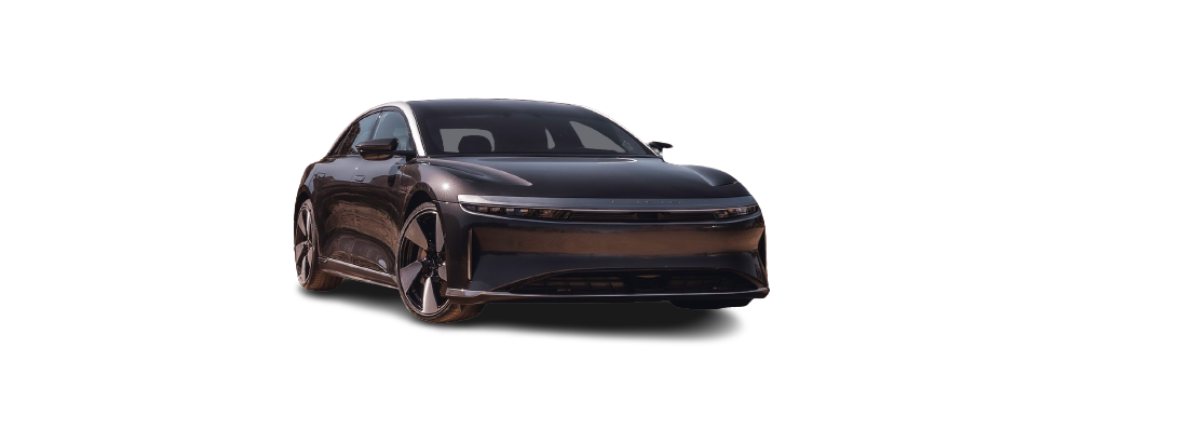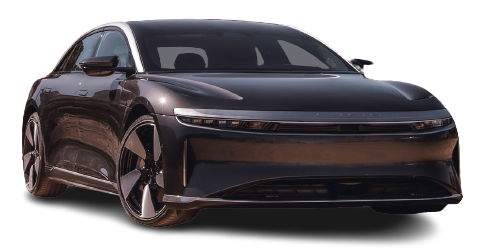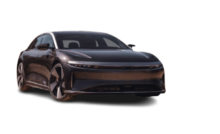2022 Lucid Air Collision Protection Owners Manual




2022 Lucid Air Collision Protection


Forward Collision Warning
- WARNING: Forward Collision Warning is an assist feature only, and is not a substitute for attentive driving and sound judgment. The driver is responsible for paying attention to the road, maintaining a suitable distance from the vehicle ahead, and braking or steering the vehicle when necessary.
- WARNING: There are factors that can reduce or impair the performance of the Forward Collision Warning system, causing either unnecessary, invalid, inaccurate, or missed warnings. Do not rely solely on forwarding Collision Warning to warn you of a potential collision.
- WARNING: Forward Collision Warning only monitors what is in frot of the vehicle. Be aware of your surroundings at all times while operating the vehicle.
- WARNING: Forward Collision Warning does not provide alerts when the driver is already applying the brake.
The Forward Collision Warning system uses the front camera mounted behind the windshield and the radar sensor mounted behind the front bumper to detect the presence of an object (such as a vehicle, bicycle, or pedestrian).
If the system detects that a collision is likely to happen, it will sound an alert and prompt you to brake in the Center Cockpit Panel. If this happens, TAKE IMMEDIATE CORRECTIVE ACTION and apply the brakes or steer clear of the impending collision.
NOTE: If the driver presses the brake, the system provides additional brake support. If you do not react sufficiently to the warning, the Automatic Emergency Braking system should reduce speed, which is intended to help reduce the severity of a collision. See Automatic Emergency Braking.
When Automatic Emergency Braking is activated, the Cockpit Panel flashes red and an audible alert sounds. If this happens, TAKE IMMEDIATE CORRECTIVE ACTION.
Forward Collision Warning settings
See Automatic Emergency Braking settings.
Automatic Emergency Braking
- WARNING: Automatic Emergency Braking is not designed to prevent a collision, but to minimize the impact of a frontal collision by attempting to reduce your driving speed. Depending solely on Automatic Emergency Braking to avoid a collision can result in serious injury or death.
- WARNING: Automatic Emergency Braking only applies the brakes. It does not steer the vehicle out of the path of the hazard.
- WARNING: There are factors that can affect the performance of Automatic Emergency Braking, causing either no braking or inappropriate or untimely braking. It is your responsibility to drive safely and remain in control of the vehicle at all times. Never depend on Automatic Emergency Braking to avoid or reduce the impact of a collision.
- WARNING: The brake pedal moves downward abruptly during Automatic Emergency Braking events. Always ensure that the brake pedal can move freely. Do not place material (including additional mats) under or on top of the vehicle-supplied floor mat and always ensure that the driver’s floor mat is secured properly. Failure to do so can impede the ability of the brake pedal to move freely.
Working in conjunction with Forward Collision Warning, the Automatic Emergency Braking system detects the presence of an object such as a vehicle, bicycle, or pedestrian. If the system determines an imminent collision with an object to the front it will initiate emergency braking to reduce the severity of the impact.
If the driver presses the brake during an Automatic Emergency Braking event, the system will provide additional brake support.
When Automatic Emergency Braking applies the brakes, an audible warning sounds, and a visual warning appears on the Cockpit Panel. You may also notice movement of the brake pedal.
NOTE: If active, the Adaptive Cruise Control and Highway Assist systems will automatically deactivate if an Automatic Emergency Braking event is triggered. See Adaptive Cruise Control
and Highway Assist.
NOTE: Automatic Emergency Braking does not apply the brakes or stops applying the brakes when:
- The steering wheel is turned abruptly.
- The brake pedal is pressed and released while Automatic Emergency Braking is applying the brakes.
- An accelerator is pressed abruptly while Automatic Emergency Braking is applying the brakes.
- Hazard (vehicle, motorcycle, bicycle or pedestrian) is no longer detected in the vehicle path.
NOTE: Automatic Emergency Braking can be adversely affected by the limitations of Advanced Driver Assistance components. See ADAS Limitations. Use appropriate caution when driving.
If Automatic Emergency Braking is unavailable, a warning message and indicator display on the Cockpit Panel. If either of these items appear, contact a Lucid Service Center.
Automatic Emergency Braking settings
WARNING: Lucid strongly recommends that you leave this feature enabled to provide potential supplemental assistance and to help avoid serious injury.
To configure Automatic Emergency Braking, from the Pilot Panel touch
Collision Protection settingS save to the current User Profile.
- When enabled, you can press to select the level of sensitivity for Forward Collision Warnings:
EARLY, NORMAL (default), or LATE.
NOTE: Sensitivity levels do not affect the actual braking distance.
NOTE: The selected sensitivity level will be saved to the current User Profile. - If you select to disable Collision Protection, you will be prompted to confirm your selection.
When Collision Protection is disabled, an indicator displays on the Cockpit Panel.
WARNING:
The Automatic Emergency Braking system automatically disables when you select Sprint mode or when you manually disable Lucid Stability Control.
Speed Limitations
The Automatic Emergency Braking System, including forwarding Collision Warning, is active at speeds above approximately 4 mph (7 km/h) and up to 112 mph (180 km/h). Pedestrian detection and reaction to stationary vehicles is active at speeds up to 53 mph (85 km/h).
Cross Traffic Protection
- WARNING: Cross Traffic Protection is an assist feature only, and is not a substitute for attentive driving and sound judgment. The driver is responsible for paying attention while driving, monitoring the suroundings, and braking or steering the vehicle when necessary.
- WARNING: There are factors that can reduce or impair the performance of the Cross Traffic Protection system, causing either unnecessary, invalid, inaccurate, or missed warnings. Do not rely solely on Cross Traffic Protection to warn you of a potential collision.
- WARNING: Cross Traffic Protection does not detect smaller objects outside of the range of the sensors. This could include (but is not limited to) small children or animals. Be aware of your surroundings at all times while operating the vehicle.
- WARNING: Cross Traffic Protection does not provide alerts when the driver is already applying the brake.
Cross Traffic Protection warns the driver when there is a risk of collision with crossing traffic approaching from the left or right to the front or rear side of the vehicle and will automatically apply emergency braking if needed.
When enabled, Cross Traffic Protection is active at speeds below 10 mph (16 km/h) for warnings, and speeds below 6 mph (10 km/h) for braking.
NOTE: Cross Traffic Protection is not available when the gear is in P (Park). Front cross traffic alerts or braking will not be issued if vehicle speed exceeds 10 km/h or driven distance is over 40m after shifting from P (Park) to D (Drive) gear.
When the gear is in D (Drive) or N (Neutral) and forward vehicle motion is detected, Cross Traffic Protection will sound an alert and prompt on the Cockpit Panel when a collision risk is detected.
If the vehicle is moving and the driver does not react in time, the system will activate emergency braking. When the gear is in R (Reverse) or N (Neutral) and backward vehicle motion is detected, Cross
Traffic Protection will sound an alert and prompt on the right Cockpit Panel when a collision risk is detected.
If the vehicle is moving and the driver does not react in time, the system will activate emergency braking.
Cross Traffic Protection settings
WARNING: Lucid strongly recommends that you do not disable Cross-Traffic Protection when driving. Disabling this feature deactivates alerts and emergency braking which increases the risk of causing or contributing to a crash.
To configure Cross-Traffic Protection, from the Pilot Panel touch > * DreamDrive, then press to enable or disable Cross-Traffic Protection. Settings save to the current User Proile.
Lane Departure Protection
- WARNING: Lane Departure Protection is for guidance purposes only and is not intended to replace your own direct visual checks. Never depend on Lane Departure Protection to inform you of unintentionally driving outside of the boundaries of the driving lane or road edge. Always stay alert, pay attention to the driving lane and always be aware of other road users. Failure to do so can result in serious injury or death.
- WARNING: Lane Departure Protection is designed to detect lane markings and certain road edges. It is your responsibility to drive attentively and stay within the boundaries of the driving lane.
- WARNING: Any changes to the vehicle’s suspension or wheel height may result in degraded feature performance or no activation.
- WARNING: Excessive crosswinds, large road crown, improper tire pressures, or vehicle loading conditions can affect the feature’s performance.
When enabled, Lane Departure Protection helps the driver to prevent the vehicle from unintentionally straying out of a detected lane by providing visual and haptic alerts (if enabled).
Lane Departure Protection is available at vehicle speeds between 30-124 mph (50-200 km/h) for detecting lanes, and between 40-85 mph (60-140 km/h) for detecting road edges.
NOTE: Lane Departure Protection is temporarily overridden when a turn signal is activated (see Turn Signals). Once you have steered into another lane and the turn signal automatically deactivates, Lane Departure Protection will resume if lane lines are detected.
When the system detects an unintentional drift toward the lane or road boundaries:
- An alert displays on the Cockpit Panel, highlighting the side the vehicle is drifting towards.
- If enabled, the steering wheel will provide a haptic vibration.
- Steering correction is applied to bring the vehicle back into the lane or road.
If two or more steering corrections are detected within 180 seconds without the driver’s hands on the steering wheel, an audible alert will sound on the second correction. For any consecutive steering corrections, audible alerts will be longer in duration.
Lane Departure Protection alerts will be canceled immediately if any of the following actions happen:
- A turn signal is activated
- Intentional steering
- Intentional acceleration
- Intentional braking
Lane Departure Protection settings
To configure Lane Departure Protection, from the Pilot Panel touch
When Lane Departure Protection is disabled or unavailable, an indicator will display on the Cockpit Panel.
When enabled, press INTERVENTION ONLY (default) or WARNING AND INTERVENTION if you wish to receive haptic vibrations of the steering wheel when a steering correction is recommended.
Warnings cancel automatically when the risk of an unintentional lane departure has been reduced (such as when you steer the vehicle back to the current lane).
NOTE: When disabled, Lane Departure Protection settings will save to the current User Profile. Lane Departure Protection is re-activated when Highway Assist is activated. See Highway Assist. When Highwav Assist is activated. it is alwavs set to ‘Warning and Intervention.
Blind Spot Warning
WARNING: Blind Spot Warning should not be used as a replacement for checking the interior and exterior mirrors or looking over your shoulder before changing lanes. It’s the driver’s obligation to stay alert, pay attention to traffic, and take action if necessary.
WARNING: Blind Spot Warning may not cover an extended blind spot zone when a trailer is attached to a detected vehicle.
Blind Spot Warning provides visual and (when enabled) audible warnings when the vehicle is in motion and the system detects an object in your blind spot or close to the side of your vehicle.
Warnings cancel automatically when the risk of a collision is no longer present, or when a vehicle is no longer detected in the blind spot.
When an object is detected in a blind spot, the amber LED in the mirror on that side will illuminate.
NOTE: If the vehicle speed is above 6 mph (10 km/h) and a turn signal is activated in the direction of the object, the amber LED in the corresponding mirror will flash.
If a turn signal is activated in the direction of the object in a blind spot, visual and (when enabled) audible warnings will activate.
If Blind Spot Display is activated, a camera view of that blind spot will also be displayed. See Blind Spot Display.
NOTE: Blind Spot Display is only available at vehicle speeds above 25 mph (40 km/h).
Blind spot warning settings
To configure Blind Spot Warning, from the Pilot Panel touch
Blind Spot Display
WARNING: Blind Spot Display should not be used as a replacement for checking the interior and exterior mirrors or looking over your shoulder before changing lanes. It is the driver’s obligation to stay alert, pay attention to traffic, and take action if necessary.
Blind Spot Display uses the exterior cameras to project an image of the blind spot field of view onto the Cockpit Panel when a turn signal is activated, helping the driver to assess the surroundings. See Iurn Signals.
NOTE: Blind Spot Display is only available at speeds above 25 mph (40 km/h).
With Blind Spot Display enabled, activating a turn signal will bring the camera view up for that side on the Center Cockpit Panel.
Blind Spot Display settings
To configure Blind Spot Display, from the Pilot Panel touch
Recent Posts
VW Jetta Engine Fuse Box Diagram
Access the comprehensive 2010-2018 VW Jetta Passenger Fuse Box Diagram to troubleshoot electrical issues effectively.…
VW Jetta Passenger Fuse Box Diagram
Explore the comprehensive VW Jetta Passenger Fuse Box Diagram to troubleshoot electrical issues effectively. Understand…
2023 Ford F-150 Lightning Fuse Box Diagram
Under Hood Fuse Box Location Remove the front luggage compartment cover. Under Hood Fuse Box…
2022 Kawasaki NINJA H2 SX SE Brake Lever Adjuster Owner’s Manual
2022 Kawasaki NINJA H2 SX SE Brake Lever Adjuster Owner's Manual NOTICE Only adjust the front…
2023 Land Rover Range Rover Evoque Exiting The Vehicle Owners Manual
2023 Land Rover Range Rover Evoque Exiting The Vehicle SINGLE LOCKING WARNING Before exiting the…
2023 Land Rover Range Rover Evoque Front Seats Owners Manual
2023 Land Rover Range Rover Evoque Front Seats FRONT SEAT SAFETY Make sure to read…
